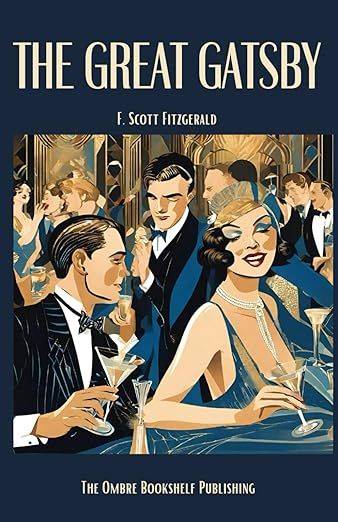Nestled on my desk, an open copy of The Great Gatsby by F. Scott Fitzgerald reveals a world of opulence, longing, and tragedy. The book, a 1940 edition published by Charles Scribner’s Sons, sits on a dark, intricately patterned fabric that seems to echo the shadowy undercurrents of the novel itself. As I turn the pages, the story unfolds with a haunting clarity, pulling me into the Jazz Age and the lives of its unforgettable characters. This isn’t just a novel-it’s a mirror reflecting the hollow pursuit of the American Dream, a theme as relevant today as it was in 1925 when the book was first published.
The passage I’ve landed on, spanning pages L-608 to L-610, offers a concise summary of the novel’s plot, a glimpse into its characters, and a stark reminder of its tragic conclusion. The Great Gatsby follows Nick Carraway, a young man who moves to West Egg, Long Island, in 1922 to chase a career in the bond business. He rents a modest house next to the lavish estate of Jay Gatsby, a mysterious millionaire known for throwing extravagant parties. Across the bay in the more fashionable East Egg live Nick’s cousin, Daisy Buchanan, and her wealthy husband, Tom. The Buchanans introduce Nick to Jordan Baker, a professional golfer, and through her, Nick learns of the tangled relationships that will unravel over the course of the summer.
At its core, The Great Gatsby is a story of unrequited love and the lengths one man will go to reclaim a past that can never be recaptured. Jay Gatsby, we learn, is deeply in love with Daisy, a woman he met and fell for years ago when he was a young, penniless soldier. Daisy, now married to the brutish and unfaithful Tom, becomes the object of Gatsby’s obsession. He throws his lavish parties in the hope that she’ll one day attend, and through Nick, he finally arranges a reunion. What follows is a brief, ill-fated affair that exposes the cracks in everyone’s carefully curated lives.
The summary on the page I’m reading captures the novel’s pivotal moments with a chilling brevity. In Chapter 7, Daisy and Gatsby drive back from New York in Gatsby’s yellow car, while Tom follows in another vehicle. On the way, Gatsby’s car, driven by Daisy, strikes and kills Myrtle Wilson-Tom’s mistress-in a hit-and-run. Myrtle’s husband, George Wilson, mistakenly believes Gatsby was the driver. Consumed by grief and rage, Wilson tracks Gatsby to his mansion, shoots him in his swimming pool, and then takes his own life. The tragedy doesn’t end there. Nick, left to arrange Gatsby’s funeral, finds that the man who once drew hundreds to his parties is now abandoned. Daisy and Tom retreat into their wealth, leaving Nick to grapple with the emptiness of their world.
What strikes me most as I sit with this book is how Fitzgerald uses Gatsby’s story to dissect the American Dream. Gatsby, born James Gatz to poor farmers in North Dakota, reinvents himself as a wealthy socialite, believing that money and status will win Daisy back. His mansion, his parties, his carefully curated image-they’re all part of a dream he’s chasing, a dream that promises happiness and fulfillment if only he can climb high enough. But Fitzgerald shows us that this dream is a mirage. Gatsby’s wealth, much of it implied to be ill-gotten through bootlegging, can’t buy him the love or acceptance he craves. Daisy, for all her charm, is shallow and incapable of the depth of love Gatsby imagines. In the end, his dream destroys him.
The characters in The Great Gatsby are as complex as they are flawed. Nick Carraway, the narrator, positions himself as an observer, someone who claims to reserve judgment. Yet, as the story unfolds, we see his growing disillusionment with the East Coast elite. He’s drawn to Gatsby’s idealism, even as he recognizes its futility. Daisy, on the other hand, is a study in contradictions-beautiful and alluring, but ultimately selfish and careless. Tom Buchanan embodies the arrogance of old money, his racism and infidelity painting him as a man who believes the world owes him everything. Jordan Baker, with her cool detachment, reflects the moral ambiguity of the era, a time when appearances mattered more than integrity.
As I reflect on the passage, I can’t help but think about the historical context that shapes the novel. The 1920s, often called the Roaring Twenties, were a time of economic prosperity and cultural upheaval in the United States. The Jazz Age brought with it flappers, jazz music, and a sense of liberation, but it also masked deeper societal issues. Prohibition, which banned the sale of alcohol, gave rise to organized crime, as bootleggers like Gatsby found ways to profit. The stark divide between old money (East Egg) and new money (West Egg) highlighted the tensions of a rapidly changing society. Fitzgerald, who lived through this era, captures its excesses and its emptiness with a keen eye.
What makes The Great Gatsby timeless is its exploration of universal themes. The pursuit of a dream, the longing for a better life, the pain of unrequited love-these are experiences that resonate across generations. Today, as we navigate our own era of inequality and materialism, Gatsby’s story feels eerily relevant. How many of us chase after an idealized version of success, only to find it hollow? How often do we prioritize wealth and status over genuine connection? Fitzgerald’s novel forces us to confront these questions, to examine the cost of our ambitions.
As I close the book, the dark, swirling pattern beneath it seems to mirror the chaos of Gatsby’s world. This 1940 edition, published 15 years after the novel’s debut, reminds me of the story’s enduring legacy. The Great Gatsby wasn’t an immediate success-Fitzgerald died in 1940 believing it had failed-but it has since become a cornerstone of American literature. Its prose, lyrical and haunting, captures the beauty and tragedy of the human condition. Its characters, flawed and unforgettable, linger long after the final page. And its message-that the past cannot be reclaimed, that dreams can destroy as much as they inspire-remains a poignant warning for us all.


